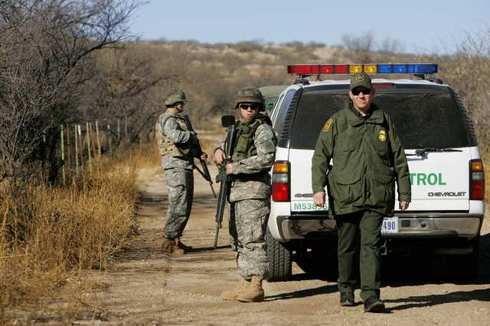Doesn’t time fly? It seems like the National Guard troops just arrived on the border, and now they are already planning to leave.
Now we hear that the force will be removed June 30. The troops were supposed to serve for a year, but that ends up being only on paper. They are several months short: maybe the problem is Obama’s famously creative accounting methods in combination with the President’s total disinterest in border security.
How true.
National Guard troops to leave Mexico border in June, USA Today, March 16, 2011
WASHINGTON — National Guard troops that have helped beef up security along the southwestern border since last summer will leave as planned by the second week of June, the commander of the Arizona Guard told a House panel Tuesday.
Maj. Gen. Hugo Salazar, adjutant general of the Guard in the state, said that the mission has gone well and that his troops have helped the Department of Homeland Security monitor the border and gather intelligence against the transnational crime cartels that smuggle drugs, weapons and cash across the border.
Matt Chandler, a spokesman for Homeland Security, said Tuesday that soldiers have helped seize over 14,000 pounds of drugs and apprehend 7,000 illegal immigrants. He said the southwestern border today has more enforcement manpower and technology than ever, much of which has been added while the National Guard has been assigned there.
President Obama’s administration announced last summer that it was sending 1,200 Guard troops to the border, including 560 to Arizona, to help beef up security for about a year.
Gov. Jan Brewer, who called for the National Guard deployment last summer and has sued the federal government for not enforcing immigration laws, said Tuesday that she was disappointed that the deployment was ending on schedule.
“It’s inexcusable and inexplicable to consider withdrawal of National Guard troops from our southern border at a time when cartel violence continues and the security of the border region remains under threat from drug and human smugglers,” she said. “Unfortunately, this appears to be further evidence that the White House is not fully committed to devoting the manpower and resources necessary to secure the border. Rather than withdrawing National Guard troops, the president ought to consider using them as a long-term tool to augment the nation’s border-security strategy.”
Chandler did not respond directly to questions about whether the Guard deployment has been a success and, if so, whether Homeland Security will seek to extend it.
Training for the troops began last summer, and deployment began in August. Full-scale operations for the armed troops on the Arizona-Mexico border began Oct. 1, Salazar said. All the National Guard troops deployed in Arizona are volunteers from the Arizona Guard. The soldiers carry firearms and are authorized to defend themselves, if necessary, but do not make arrests. Instead, they serve as additional eyes and ears for law enforcement.
“The Arizona National Guard has supported the Department of Homeland Security in a commendable manner, and the working relationship between National Guard and law enforcement has been nothing short of exemplary,” Salazar told members of the House Homeland Security Committee.
‘Unit readiness’
Although clearly proud of his troops’ work on the border, Salazar said he is concerned that they cannot attend monthly drills with their regular units in Arizona.
“This creates a negative impact on unit readiness and especially when the individual volunteering to serve on Operation Phalanx is in a leadership position at his/her unit,” Salazar said.
U.S. Customs and Border Protection officials, who also testified Tuesday, said the temporary deployment of the National Guard troops has given them time to hire additional agents and put more surveillance equipment and communications’ systems into place.
There are now more than 20,700 Border Patrol agents, Border Patrol Chief Michael Fisher said.
An emergency $600 million spending bill passed by Congress last year has allowed the Homeland Security to add 1,000 Border Patrol agents, 250 CBP officers at ports of entry and two unmanned aircraft that provide surveillance along the border, Homeland Security officials said.
Pinal County Sheriff Paul Babeu, a former National Guard major who served in 2006 as commander of troops on the border near Yuma, said the removal of troops would be “an indication that the administration is not willing to do exactly what it takes to secure the border.”
Costs of deployment
Funding for the deployment of the Guard was initially budgeted for $135 million but was reduced to $110 million, Salazar said. The cost of Arizona’s portion is estimated at $34 million through the end of June, he said. The Defense Department is paying for the deployment, Homeland Security officials said.
In other testimony before the House committee, an official from the Government Accountability Office said high-tech radar, camera and sensor systems designed to replace a virtual fence will be installed gradually in Arizona over the next two years but may not be fully installed for several years.













